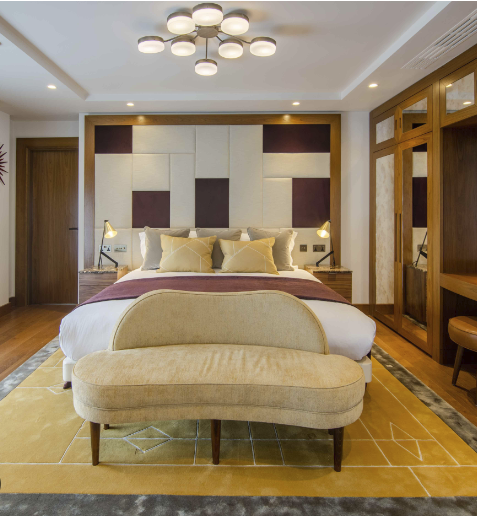Thoughtful decoration in hotels is crucial for creating a memorable guest experience. The interior design of a hotel can greatly impact the mood and behavior of guests, as well as their perception of the hotel brand. From the colors used in the decor to the furniture selection and even the textiles and fabrics, every element plays a role in shaping the overall ambiance of a hotel. In this article, we will explore the various ways in which interior design can enhance the guest experience and provide tips and examples for creating a welcoming and memorable atmosphere.
Understanding the Impact of Interior Design on Hotel Experience
The interior design of a hotel can have a significant impact on guest mood and behavior. A well-designed space can create a sense of calm and relaxation, making guests feel more at ease during their stay. On the other hand, a poorly designed space can make guests feel uncomfortable or even stressed, leading to a negative experience.
In addition to influencing guest mood, interior design also plays a role in shaping guest perception of the hotel brand. The design elements used in a hotel can convey a sense of luxury, sophistication, or even playfulness, depending on the desired brand image. For example, a boutique hotel may use unique and eclectic decor to create a sense of individuality and charm, while a luxury hotel may opt for more elegant and refined design elements.
The Role of Color in Creating a Memorable Hotel Stay
Color is an important element in hotel design as it has the power to evoke emotions and set the tone for a space. Different colors have different psychological effects on people, and understanding these effects can help designers create an atmosphere that aligns with the desired guest experience.
For example, warm colors like reds and oranges can create a sense of energy and excitement, making them ideal for areas such as lobbies or restaurants where social interaction is encouraged. On the other hand, cool colors like blues and greens can create a calming and relaxing atmosphere, making them suitable for guest rooms or spa areas.
There are many hotels that use color effectively to create a memorable stay. The Ace Hotel in Palm Springs, for instance, uses vibrant pops of color throughout its design to create a playful and energetic atmosphere. The use of bright yellow accents against a backdrop of neutral tones creates a sense of warmth and fun, making guests feel instantly welcome and at ease.
Using Lighting to Enhance the Guest Experience
Lighting is another crucial element in hotel design that can greatly impact the guest experience. Proper lighting can create a welcoming and inviting atmosphere, while poor lighting can make a space feel cold and unwelcoming.
In hotel design, it is important to consider both natural and artificial lighting. Natural light can create a sense of openness and connection to the outside world, while artificial lighting can be used to create different moods and highlight specific areas or features.
To create a welcoming atmosphere, it is important to use a combination of ambient, task, and accent lighting. Ambient lighting provides overall illumination and sets the general mood of a space, while task lighting is used for specific activities such as reading or working. Accent lighting is used to highlight architectural features or decorative elements.
The Benefits of Incorporating Art and Decorative Elements in Hotel Design
Art and decorative elements play a crucial role in enhancing the guest experience in hotels. They can add visual interest, create a sense of uniqueness, and even tell a story about the hotel’s brand or location.
Artwork Orderpen can be used to create focal points in a space and add personality to the design. It can also serve as a conversation starter and provide guests with a sense of cultural immersion. For example, a hotel located in a city known for its art scene may choose to display local artwork throughout its public spaces to showcase the local culture.
Decorative elements such as sculptures, vases, or unique furniture pieces can also add visual interest and create a sense of luxury or sophistication. These elements can be strategically placed in key areas such as lobbies or guest rooms to create a memorable and immersive experience for guests.
Creating a Cozy Atmosphere with Textiles and Fabrics

Textiles and fabrics play a crucial role in creating a cozy and comfortable atmosphere in hotels. From the bedding and curtains to the upholstery and rugs, every fabric choice can contribute to the overall ambiance of a space.
Soft and plush fabrics can create a sense of luxury and comfort, making guests feel pampered during their stay. On the other hand, natural and organic fabrics can create a more relaxed and eco-friendly atmosphere, appealing to guests who value sustainability.
In addition to the choice of fabrics, it is also important to consider the color and pattern of textiles. Warm and earthy tones can create a cozy and inviting atmosphere, while bold patterns can add visual interest and create a sense of playfulness.
The Importance of Furniture Selection in Hotel Decoration
Furniture selection is an important aspect of hotel decoration as it not only impacts the overall aesthetic of a space but also plays a crucial role in guest comfort and functionality.
When selecting furniture for hotels, it is important to consider both style and functionality. The furniture should align with the desired brand image while also providing guests with comfortable seating options, ample storage space, and functional work areas.
In addition to style and functionality, it is also important to consider the durability and maintenance requirements of the furniture. Hotels experience high levels of foot traffic, so it is important to choose furniture that can withstand frequent use and is easy to clean and maintain.
Maximizing Space and Functionality in Hotel Design
Space planning is a crucial aspect of hotel design as it impacts both guest comfort and operational efficiency. Proper space planning can help maximize the functionality of a space while also creating a comfortable and welcoming atmosphere.
To maximize space and functionality in hotel rooms, it is important to consider the layout and arrangement of furniture, as well as the placement of amenities such as storage space and work areas. For example, incorporating built-in storage solutions can help maximize space and reduce clutter, while a well-designed work area can provide guests with a functional space to work or relax.
In addition to guest rooms, space planning is also important in common areas such as lobbies, restaurants, and conference rooms. These areas should be designed in a way that allows for easy circulation and social interaction while also providing guests with comfortable seating options and functional amenities.
Incorporating Technology for a Modern Hotel Experience
In today’s digital age, technology plays a crucial role in hotel design. From smart room controls to interactive displays, incorporating technology can greatly enhance the guest experience and provide added convenience and comfort.
For example, many hotels now offer keyless entry systems that allow guests to access their rooms using their smartphones. This not only eliminates the need for physical keys but also provides added security and convenience.
Other technological advancements in hotel design include in-room tablets that allow guests to control various aspects of their stay, such as room temperature and lighting, as well as access hotel services and information. Interactive displays in common areas can also provide guests with real-time information about local attractions, events, or dining options.
Examples of Successful Hotel Decoration and Design Transformations
There are many examples of hotels that have undergone successful decoration and design transformations, greatly enhancing the guest experience. One such example is the Hoxton Hotel in London. The hotel underwent a complete renovation that transformed it from a run-down office building into a trendy and stylish boutique hotel.
The design transformation included the use of bold colors, unique furniture pieces, and eclectic artwork throughout the hotel. The result is a vibrant and energetic atmosphere that appeals to a younger demographic and creates a memorable stay for guests.
Another example is the Four Seasons Hotel in New York City. The hotel recently underwent a renovation that focused on creating a more modern and luxurious atmosphere. The design transformation included the use of high-end materials, elegant furniture pieces, and sophisticated lighting fixtures. The result is a refined and sophisticated ambiance that aligns with the hotel’s luxury brand image.
Thoughtful decoration in hotels is crucial for creating a memorable guest experience. From the colors used in the decor to the furniture selection and even the textiles and fabrics, every element plays a role in shaping the overall ambiance of a hotel. Interior design can greatly impact guest mood and behavior, as well as their perception of the hotel brand. By understanding the impact of interior design on the guest experience and incorporating elements such as color, lighting, art, textiles, furniture, space planning, and technology, hotels can create a welcoming and memorable atmosphere that leaves a lasting impression on guests.
If you’re looking for inspiration on how to transform your hotel’s decor, look no further than this insightful article on Sincerely Savannah. In their post titled “The Art of Hotel Decoration,” they delve into the importance of creating a visually appealing and inviting atmosphere for guests. From choosing the right color palette to incorporating unique design elements, this article offers valuable tips and tricks to elevate your hotel’s aesthetic. Check it out here for expert advice on enhancing your hotel’s decor.





